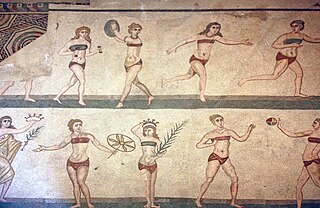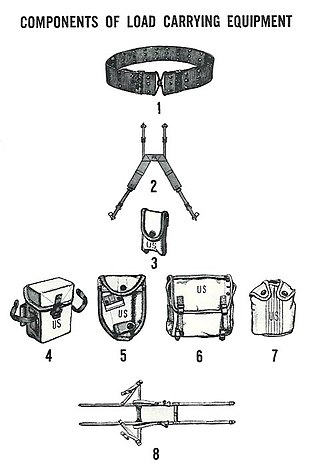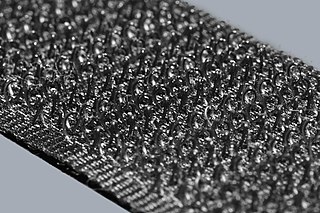
A hook-and-eye closure is a simple and secure method of fastening garments together. It consists of a metal hook, commonly wire bent to shape, and an eye (or "eyelet") of the same material into which the hook fits.

A hook-and-eye closure is a simple and secure method of fastening garments together. It consists of a metal hook, commonly wire bent to shape, and an eye (or "eyelet") of the same material into which the hook fits.

The hook and eye closure has a long history and is still used today, primarily on bras.
This form of fastening first appears under the name of "crochet and loop" in 14th-century England. [1]
The first reference to the modern term appears in Aubrey's Brief Lives in 1697, which describes a doublet and breeches being attached with "hook and eies". [2] Hooks and eyes were made by hand from wire, until the town of Redditch, England, already famous for sewing needle manufacture, was the first to machine-manufacture them. In 1643 a woman in the American colony of Maryland is recorded as having paid £10 worth of tobacco for hooks and eyes. [3]
The hook and eye played an important role in women's corsetry; used in rows or as a busk, they can take the stress necessary to support the bust and are used for a lady to be able to independently fasten her corset at the front rather than one's only option being to lace it at the back.
It was not until the first part of the 19th century that the industry was furthered in the United States. In 1830, one of the innovators in mass-producing hooks and eyes was Henry North of New Britain, Connecticut; he commissioned a man in Hartford named Levi Lincoln to make a machine that automated the creation of these fasteners. [4]
One variation of the attachment incorporates a "Delong hump", patented in 1889 by the Richardson & Delong Hook and Eye Company of Philadelphia, Pennsylvania. This was a raised elevation or "hump" in the wire hook that prevented the eye from slipping out of the hook, "except at the will of the wearer". [5]
In 1893, Marie Tucek patented the "Breast Supporter" – the first garment similar to the modern-day bra, which used separate pockets for the breasts and straps that went over the shoulder and fastened by hook-and-eye closures to the center front of the garment. [6]
E.C. Beecher patented his hook-and-eye in June 1900 with the U.S. Patent Office; in 1902, an updated version was submitted that consisted of an attachable hook-and-eye, without any stitching required. [7] A similar hook and eye for brassieres was patented in 1902 by the M.E. Company. [8]
The fasteners were eventually manufactured in the form of hook-and-eye tape, consisting of two tapes, one equipped with hooks and the other equipped with eyelets so that the two tapes could be "zipped" together side by side. To construct the garment, sections of hook-and-eye tape were sewn into either side of the garment closure. Today this labor-saving method comes on either silk or cotton tape, depending on the firmness and strength needed.
To keep up with the modern machine-oriented production environment, hook-and-eye closures are sold both individually and as a ready-to-cut tape. Ready-to-cut tapes are seen mostly in underwear such as bras. The metal part of the closures also comes in stainless steel, nylon-coated wires or brass in quality products.
In addition to their application on brassieres, bustiers, corsets and other fine lingerie, a single hook-and-eye closure is often sewn above the top of the zipper to "finish" it and take stress off the fastening on a skirt, dress or pants. They are generally provided at one gross to a box and range in size from No. 1 small, to No. 10 large.

A zipper, zip, fly, or zip fastener, formerly known as a clasp locker, is a commonly used device for binding together two edges of fabric or other flexible material. Used in clothing, luggage and other bags, camping gear, and many other items, zippers come in a wide range of sizes, shapes, and colors. In 1892, Whitcomb L. Judson, an American inventor from Chicago, patented the original design from which the modern device evolved.

Gideon Sundbäck was a Swedish-American electrical engineer, who is most commonly associated with his work in the development of the zipper.

A fastener or fastening is a hardware device that mechanically joins or affixes two or more objects together. In general, fasteners are used to create non-permanent joints; that is, joints that can be removed or dismantled without damaging the joining components. Steel fasteners are usually made of stainless steel, carbon steel, or alloy steel.

A nursing bra is a specialized brassiere that provides additional support to women who are lactating and permits comfortable breastfeeding without the need to remove the bra. This is accomplished by specially designed bra cups that include flaps which can be opened with one hand to expose the nipple. The flap is usually held closed with a simple clasp or hook.

In women's clothing, a corselet or corselette is a type of foundation garment, sharing elements of both bras and girdles. It extends from straps over the shoulders down the torso, and stops around the top of the legs. It may incorporate lace in front or in back. As an undergarment, a corselet can be open-style or panty-style.

Whitcomb L. Judson was an American machine salesman, mechanical engineer and inventor. He received thirty patents over a sixteen-year career, fourteen of which were on pneumatic street railway innovations. Six of his patents had to do with a motor mechanism suspended beneath the rail-car that functioned with compressed air. He founded the Judson Pneumatic Street Railway.

A snap fastener, also called snap button, press stud, press fastener, dome fastener, popper, snap and tich, is a pair of interlocking discs, made out of a metal or plastic, commonly used in place of traditional buttons to fasten clothing and for similar purposes. A circular lip under one disc fits into a groove on the top of the other, holding them fast until a certain amount of force is applied. Different types of snaps can be attached to fabric or leather by riveting with a punch and die set specific to the type of rivet snaps used, sewing, or plying with special snap pliers.

The history of bras is closely tied to the social status of women, the evolution of fashion, and shifting views of the female body over time.

Talon was the first slide fastener, a/k/a zipper, manufacturing company. It was founded in 1893 as the Universal Fastener Company, manufacturing hookless fasteners for shoes. In 1913 it moved to Meadville, Pennsylvania, becoming the first manufacturer of zippers. The company flourished through the 1960s when it is estimated that seven out of every 10 zippers were made by Talon.

The M-1956 Load-Carrying Equipment (LCE), also known as the Individual Load-Carrying Equipment (ILCE), was developed by the U.S. Army and first issued in the early 1960s. The M-1956 LCE was designed to replace the M-1945 Combat Pack, the M-1923 cartridge belt, the M-1936 pistol belt and the M-1937 BAR magazine belt. The M-1956 LCE was designed to be quickly configured, using no tools, to accommodate various mission and ammunition loads. The M-1956 LCE remained in service through the 1980s and set the standard for future United States military load-carrying equipment.

A bandeau is a garment comprising, in appearance, a strip of cloth. Today, the term frequently refers to a garment that wraps around a woman's breasts. It is usually part of a bikini in sports or swimwear. It is similar to a tube top, but narrower. It is usually strapless, sleeveless, and off the shoulder. Bandeaux are commonly made from elastic material to stop them from slipping down, or are tied or pinned at the back or front. In the first half of the 20th century, a "bandeau" was a narrow band worn by women to bind the hair, or as part of a headdress.
A back closure is a means for fastening a garment at the rear, such as with a zipper, hooks-and-eyes or buttons. Back closures were once common on Western female clothing, but have recently become less so, especially on female casual and business attire. They continue, however, to be widely used in underwear, formal wear and specialized clothing. Back closures are also common in garments for infants and toddlers.
A bra, short for brassiere or brassière, is a form-fitting undergarment that is primarily used to support and cover a woman's breasts. A typical bra consists of a chest band that wraps around the torso, supporting two breast cups that are held in place by shoulder straps. A bra usually fastens in the back, using a hook and eye fastener, although bras are available in a large range of styles and sizes, including front-fastening and backless designs. Some bras are designed for specific functions, such as nursing bras to facilitate breastfeeding or sports bras to minimize discomfort during exercise.

Underwear, underclothing, or undergarments are items of clothing worn beneath outer clothes, usually in direct contact with the skin, although they may comprise more than a single layer. They serve to keep outer clothing from being soiled or damaged by bodily excretions, to lessen the friction of outerwear against the skin, to shape the body, and to provide concealment or support for parts of it. In cold weather, long underwear is sometimes worn to provide additional warmth. Special types of undergarments have religious significance. Some items of clothing are designed as undergarments, while others, such as T-shirts and certain types of shorts, are appropriate both as underwear and outerwear. If made of suitable material or textile, some underwear can serve as nightwear or swimwear, and some undergarments are intended for sexual attraction or visual appeal.

Rings, slides and hooks are the accessories used in intimate apparel/lingerie used for adjustment and decorative functions. Rings, slides and hooks are commonly made of plastic and nylon coated metal and stainless steel.

An underwire bra is a brassiere that utilizes a thin, semi-circular strip of rigid material fitted inside the brassiere fabric to help lift, separate, shape, and support a woman's breasts. The wire may be made of metal, plastic, or resin. It is sewn into the bra fabric and under each cup, from the center gore to under the wearer's armpit. Many different brassiere designs incorporate an underwire, including shelf bras, demi bras, nursing bras, and bras built into other articles of clothing, such as tank tops, dresses and swimsuits.

A pin-back button or pinback button, pin button, button badge, or simply pin-back or badge, is a button or badge that can be temporarily fastened to the surface of a garment using a safety pin, or a pin formed from wire, a clutch or other mechanism. This fastening mechanism is anchored to the back side of a button-shaped metal disk, either flat or concave, which leaves an area on the front of the button to carry an image or printed message. The word is commonly associated with a campaign button used during a political campaign. The first design for a pin-back button in the United States was patented in 1896, and contemporary buttons have many of the same design features.

Hook-and-loop fasteners, hook-and-pile fasteners or touch fasteners consist of two components: typically, two lineal fabric strips which are attached to the opposing surfaces to be fastened. The first component features tiny hooks; the second features smaller loops. When the two are pressed together the hooks catch in the loops and the two pieces fasten or bind temporarily. When separated, by pulling or peeling the two surfaces apart, the strips make a distinctive ripping sound.

A girdle is a form-fitting foundation garment that encircles the lower torso, extending below the hips, and worn often to shape or for support. It may be worn for aesthetic or medical reasons. In sports or medical treatment, a girdle may be worn as a compression garment. This form of women's foundation replaced the corset in popularity, and was in turn to a larger extent surpassed by pantyhose in the 1960s.

A metal zipper is a zipper with its binding edges consisting of individual pieces of metal that are molded into shape and set at regular intervals on the zipper tape. Metal zippers are mainly made of brass, nickel and aluminium, and given their durability, they are mostly used in jeans, work-wear, heavy luggage and heavy-duty garments that must withstand high strength and tough washing. The metal zipper is the oldest type of workable zipper, having been invented by Gideon Sundback as an improvement of Whitcomb Judson's "Clasp Locker" that majorly consisted of a hook-and-eye shoe fastener.